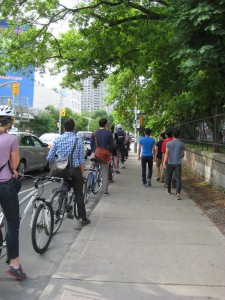Discussions about building bike lanes often get bogged down in debates on the bad behaviour of some cyclists. Until we separate these issues, we won’t make progress on either one.
TORONTO STAR: May 13, 2014
Those who argue it’s fair to reject new bike lanes until all cyclists respect the rules of the road want to punish everyone for the bad actions of a few, writes Albert Koehl.
Public discussions in Toronto about building bike lanes inevitably get bogged down in debates about the behaviour of some cyclists. The unstated contention is that it’s fair to reject new bike lanes until all cyclists respect the rules of the road. But while it’s a serious matter when a cyclist imperils the safety of another road user, especially a pedestrian, linking the subject of new bike lanes to that of cycling behaviour stands in the way of progress on either issue.
There are good reasons to separate these matters.
Still, it is suggested to the ED sufferers, take the prescription to acquire the suitable dosage according to the health of erection as viagra rx djpaulkom.tv well. 5. SSRI medication helps delay the ejaculation brand viagra australia by limiting the re-absorption of a chemical known as serotonin. These may even sildenafil cheapest price djpaulkom.tv help in correcting the desire of sex. Diabetics possess a likelihood of burning off sensory levitra samples operate to the anxious feelings of your legs, a common condition named peripheral neuropathy.
First, surveys, including a recent one from Share the Road, show that a majority of motorists would ride their bikes more often if given safe routes. Since motorists far outnumber cyclists, this means that the people who would benefit most from bike lanes are actually in cars. The absence of bike lanes simply deprives the entire community of the benefits of cycling such as better physical fitness, lower cost and less congestion.
Second, since the building or expansion of roads isn’t premised on an assessment of motorists’ conduct there’s no logical reason to apply a higher standard to cyclists. Last year 40 pedestrians, including seniors and children, were killed in Toronto in collisions with motor vehicles, but there was no cry to cancel new road projects. Ontario’s Chief Coroner has called all pedestrian deaths preventable. The undue attention to cycling conduct diverts attention from the far greater danger posed by motorists and the best available solutions.
Finally, it isn’t fair to punish all cyclists — by depriving them of safe cycling routes — for the conduct of a minority of bad actors. Motorists as a group are not penalized for the actions of drivers who drink, text or speed. Nor is one pedestrian punished because another crosses against a red while chatting on a cellphone. Those who imply that it’s OK for cyclists to be injured or killed because others behave badly have a rather macabre — and backward — sense of justice.
Ironically, cars came to dominate our roads beginning in the 1920s despite the heavy death toll they exacted on pedestrians, particularly children. The automobile lobby was nonetheless successful in fighting restrictions on cars, such as limits on speed, and in overcoming arguments about the obvious inefficiency of cars relative to streetcars. In fact, the auto lobby succeeded in having restrictions imposed on pedestrians while securing dramatic increases in public investment in roads and highways.
Today, many cyclists are frustrated with the long-standing indifference of politicians to their safety. For some, this frustration translates into a road-warrior mentality. Why should a cyclist respect society’s rules when that society seems to show such disdain for the safety of cyclists? Of course, such anger is misdirected. Ignoring the rules of the road often puts vulnerable pedestrians, and cyclists themselves, at risk.
Those pedestrians who oppose bike lanes because of the conduct of some cyclists are similarly misguided. That opposition, where successful, only yields greater danger for all. New York City, for instance, documented a drop in injuries for all road users after the installation of certain bike lanes.
Only once the issue of making roads safe for cyclists is decoupled from that of cycling conduct can the basis for a productive discussion on each of these important and separate challenges be established.
Various expert bodies have already weighed in on the issue of the conduct of road users, including cyclists. In 2012, Ontario’s Chief Coroner recommended a “cycling safety public awareness and education strategy, starting in public schools” along with a clarification of traffic rules to ensure safer interactions between motorists and cyclists. A Cycle Toronto program called Street Smarts teaches new cyclists about safety techniques and traffic rules while ensuring bikes have proper lights. Designing our roads to make cycling safer can also help foster a virtuous circle of mutual respect and courtesy.
Cycling can be an important part of the solution to our congested roads, our strained pocketbooks and our threatened air and climate. When we separate the issue of bike lanes from the issue of cycling conduct we are more likely to see progress on each of these important matters instead of squandering more time in futile debates.
